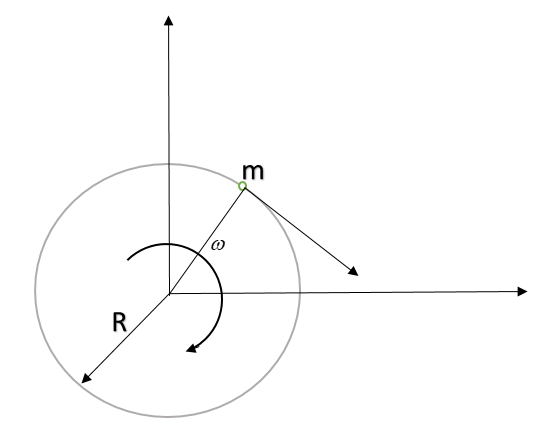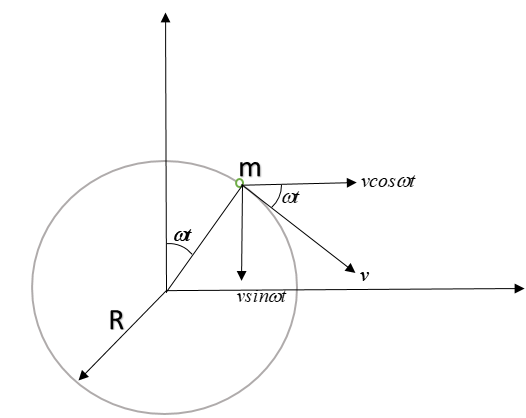
Justify the statement – “Uniform circular motion is an accelerated motion “. Hence derive an expression for the centripetal acceleration of an object in a uniform circular motion in a plane.
Answer
579.6k+ views
Hint: Uniform circular motion in a plane means that the angular velocity of the particle undergoing circular motion is constant with time. One should always take care of the difference between scalar and vector quantity. Speed is a scalar quantity and on the other, velocity is a vector quantity. If the speed is constant, it doesn’t imply that the acceleration is zero but if the velocity is constant, it always implies that acceleration is zero or motion is non-accelerated.
Formula used:
$a= \dfrac{dv}{dt}$, $v=R \omega$
Complete step by step answer:
To understand the statement mathematically, let’s consider a particle undergoing circular motion with angular speed $\omega$ and radius ‘R’.

Starting from t=0, the angle turned by the particle after ‘t’ time will be $\omega t$ as shown in the figure below.

Let the magnitude of linear velocity of the particle be ‘$v$’ that is equal to $R \omega$. Hence resolving the velocity into x and y components, so: $\vec { v } =\quad (vcos\omega t\hat { )i } -(vsin\omega t)\hat { j }$
To find the acceleration of the particle, let's differentiate the velocity expression.
$a= \dfrac{dv}{dt}$
$a= \dfrac{d((vcos\omega t\hat { )i } -(vsin\omega t)\hat { j })}{dt}$ = $v \omega (-sin \omega t) \hat i - v \omega (cos \omega t) \hat j$ = $-v \omega (sin \omega t \ \hat i+cos \omega t \ \hat j)$
Putting $v=R \omega$, we get
$\vec a = -\omega R^2 ( sin \omega t\ \hat i + cos \omega t\ \hat j)$
Hence we can clearly see that acceleration is non zero. Hence uniform circular motion is accelerated motion. So, the statement is justified.
Expression for centripetal acceleration of a body undergoing circular motion:
As we derived $\vec a = -\omega R^2 ( sin \omega t\ \hat i + cos \omega t\ \hat j)$
To find the magnitude:
$|\vec a| = \omega R^2 \sqrt{(sin \omega t)^2 + (cos \omega t)^2}$ = $\omega R^2$ [ $sin^2 \theta + cos^2 \theta = 1$]
Hence centripetal acceleration is $\omega R^2$.
Note:
As we derived the expression for the centripetal acceleration of the body undergoing uniform circular motion, we can see that the magnitude of this acceleration is constant with time. One should always analyze the quantities with their directions and magnitude separately. For example, the magnitude of centripetal acceleration is $\omega R^2$ but its direction is radially inwards (along the string). In short, we can say that the string is providing necessary centripetal force so that the particle can undergo circular motion.
Formula used:
$a= \dfrac{dv}{dt}$, $v=R \omega$
Complete step by step answer:
To understand the statement mathematically, let’s consider a particle undergoing circular motion with angular speed $\omega$ and radius ‘R’.

Starting from t=0, the angle turned by the particle after ‘t’ time will be $\omega t$ as shown in the figure below.

Let the magnitude of linear velocity of the particle be ‘$v$’ that is equal to $R \omega$. Hence resolving the velocity into x and y components, so: $\vec { v } =\quad (vcos\omega t\hat { )i } -(vsin\omega t)\hat { j }$
To find the acceleration of the particle, let's differentiate the velocity expression.
$a= \dfrac{dv}{dt}$
$a= \dfrac{d((vcos\omega t\hat { )i } -(vsin\omega t)\hat { j })}{dt}$ = $v \omega (-sin \omega t) \hat i - v \omega (cos \omega t) \hat j$ = $-v \omega (sin \omega t \ \hat i+cos \omega t \ \hat j)$
Putting $v=R \omega$, we get
$\vec a = -\omega R^2 ( sin \omega t\ \hat i + cos \omega t\ \hat j)$
Hence we can clearly see that acceleration is non zero. Hence uniform circular motion is accelerated motion. So, the statement is justified.
Expression for centripetal acceleration of a body undergoing circular motion:
As we derived $\vec a = -\omega R^2 ( sin \omega t\ \hat i + cos \omega t\ \hat j)$
To find the magnitude:
$|\vec a| = \omega R^2 \sqrt{(sin \omega t)^2 + (cos \omega t)^2}$ = $\omega R^2$ [ $sin^2 \theta + cos^2 \theta = 1$]
Hence centripetal acceleration is $\omega R^2$.
Note:
As we derived the expression for the centripetal acceleration of the body undergoing uniform circular motion, we can see that the magnitude of this acceleration is constant with time. One should always analyze the quantities with their directions and magnitude separately. For example, the magnitude of centripetal acceleration is $\omega R^2$ but its direction is radially inwards (along the string). In short, we can say that the string is providing necessary centripetal force so that the particle can undergo circular motion.
Recently Updated Pages
Why are manures considered better than fertilizers class 11 biology CBSE

Find the coordinates of the midpoint of the line segment class 11 maths CBSE

Distinguish between static friction limiting friction class 11 physics CBSE

The Chairman of the constituent Assembly was A Jawaharlal class 11 social science CBSE

The first National Commission on Labour NCL submitted class 11 social science CBSE

Number of all subshell of n + l 7 is A 4 B 5 C 6 D class 11 chemistry CBSE

Trending doubts
What is meant by exothermic and endothermic reactions class 11 chemistry CBSE

10 examples of friction in our daily life

One Metric ton is equal to kg A 10000 B 1000 C 100 class 11 physics CBSE

1 Quintal is equal to a 110 kg b 10 kg c 100kg d 1000 class 11 physics CBSE

Difference Between Prokaryotic Cells and Eukaryotic Cells

What are Quantum numbers Explain the quantum number class 11 chemistry CBSE




